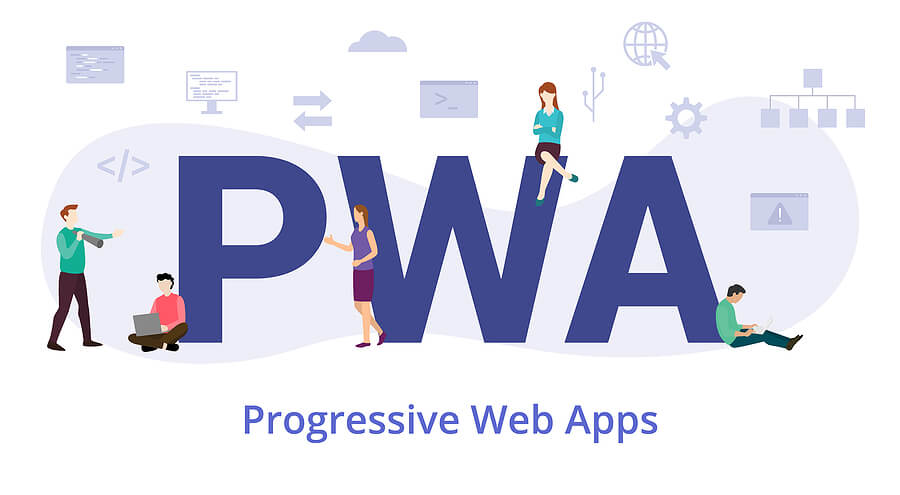What are Progressive Web Apps? | Real World Examples and Benefits
Progressive web apps (PWA) act as a bridge between the limitations of traditional websites and the resource-draining native apps. They are web applications that have...

Web browsing, or, more precisely, web surfing, has dramatically changed its appearance. In today's world, smartphones have become the biggest part of our lives. It is rare for one to use the Internet on their mobile device and not find a site that loads slowly, was built for the PC, and has hard-to-click icons. Just think about it: you want to look at a recipe on your phone, and all you get is the scroll of doom.
There's a solution! PWAs act as a bridge between the limitations of traditional websites and the resource-draining native apps. It provides a smooth and responsive experience that is as good as a native application but without the need to download the app from an app store.
The main benefit of PWAs is that you will be exploring the app with a frustration-free browsing experience. Research shows that over 60.67% of all web browsing now happens on mobile phones. The dramatic change in the usage of smartphones underlines the necessity to develop mobile-first models. PWAs are a great solution for all users since they provide both consumers and business companies with benefits.
Are PWAs the future? In this article, we will explore this technology, see how it benefits everyone, and understand its potential to change how we use the web on our phones.
What are PWAs?
Imagine a website that is as engaging as a native application. That is where Progressive Web Apps (PWAs) show their magic. They are web applications that have additional features, like a mobile app, without any need to download from the app store. PWAs solve the challenges of heavy websites and resource-intensive native apps to provide an smooth experience on any mobile device.
Progressive power:
Thus, the “progressive” part of PWAs is key to its success. They are optimized to be used on any device, no matter whether it is an old or a new model or has a weak Internet connection. This means that all the users have the best experience, irrespective of the features of the phone they are using. It is like having a website that optimizes itself for the phone and gives the best experience it can. This aligns perfectly with the current web development trends of creating responsive and accessible experiences for all users.
What technology is behind the magic:
Thus, how does PWA do this? Three key technologies work together:
- Service workers: These are the helpers that work in the background. They make PWAs function offline, get push notifications as your news app does, and even update the content in the background, so you do not need to refresh the page.
- Web App manifest: It is like a user guide for your phone. It offers instructions on how the PWA must be displayed on your home screen, the icon to use, and letting you ‘add’ the PWA to your home screen like any other native app.
- HTTPS: Security is paramount. This is important because HTTPS guarantees a secure connection to the PWA from your phone, acting as a safeguard for your information.
All of these technologies mesh together to provide you with a seamless, integrated experience that feels more like a native application but with all the benefits of a Web site.
Why You Should Care About PWAs
1.) Benefits for a user:
Just think how easy it is to scroll through a website that is as smooth as one of your apps. With PWAs, that's exactly what you get. It is a thing of the past to have slow loading pages, poor design, and an unclear call to action. PWAs are built for mobile-first experiences, offering:
Enhanced user experience
PWAs are designed for easy scrolling, a nice UI, and fast page loads. This leads to a frustration-less user experience that is as crisp and smooth as using a native application. No more waiting for the pages to load or the attempt to fit the content into the page layout that suits the desktop screens. PWAs ensure that the use of the internet on your phone is as exciting as it should be.
Offline champion
If an Internet connection is not available, no problem! PWAs can work even if your device has no internet connection. This functionality enables the users to retrieve the contents they had earlier saved, resume activities that the user had begun before, such as writing an email, and continue from the exact point which the user left in case he or she logs out. It offers great convenience and eliminates the possibility of a disrupted internet connection disrupting your mobile surfing.
Stay in the loop with push notifications
PWAs can use push notifications like your favorite apps do. Be notified of some exclusive deals for the product, order status, or any urgent event—without having to open the app all the time. This makes it possible for you to be connected to the PWA without necessarily having to open it. It is one of the most effective methods of keeping clients informed and, at the same time, making them come back for more.
Seamless discovery
Unlike native apps that have to be searched through app stores, PWAs are SEO-friendly, just like websites. This means you can easily find them through a simple Google search or by using other search engines. Just think about the case when you are looking for a particular recipe or a business located nearby, and here you see the PWA in the search results. PWAs are more discoverable and easier to find as compared to apps since they are more of a native content or service on your mobile device.
2.) Benefits for Businesses:
Just as PWAs are beneficial for users, they are also advantageous for businesses. Here's how:
Cost-effective champion
Creating and updating native applications for different platforms like iOS, Android, and so on can be costly. PWAs are beneficial in that they present a single codebase solution. This implies that you develop one PWA that is optimized for use on any device, regardless of the operating system in use. This means less expenditure on development and maintenance, yet you can be able to cover a large market.
Wider reach
Cast a Wider Net: Just forget the limitations of device compatibility and operating systems. PWAs work on any device, no matter what operating system or brand a user uses. This makes you able to cover a much wider audience as compared to native applications. If users are using iPhones, Android, or any other device, or even old generation smart phones, then your PWA will be easily available. This in turn increases the marketing audience reach and brings new opportunities to access customers that possibly could not be reached before due to platform limitations.
Improved conversion rates
Engagement is Key The key to a higher conversion rate is to engage the audience with the help of PWAs. Features like "add to home screen" allow a user to easily access your PWA through a shortcut. Also, with features such as offline availability and push notifications, the user is likely to come back to continue the required actions, thus increasing the conversions.
Data-driven decisions
Track What Counts Similar to native apps, there are opportunities to use web analytics tools to measure user behavior and get insights about the PWA. It enables one to learn how users engage with your app, ascertain problems, and enhance the user experience. Understanding user behavior enables you to make decisions that will help to improve your progressive web app and, in the end, increase the conversion rate and, therefore, the success of your business.
Real-world Examples of PWAs
PWAs are the newest trend in the market that has found application across industries. Here are a few examples:
- Uber: The global giant in the ride-sharing industry, utilizes a PWA to provide a seamless booking experience even with low-end devices that have limited internet connectivity. This allows them to reach a vast audience and increase user engagement.
- Starbucks: Need a cup of latte but are unable to get it? Starbucks’ PWA allows users to view the menus, order takeout, and even pay via phone. This simplifies the ordering process, makes it more efficient, and increases the satisfaction of the customers.
- Pinterest: This is one of the most widely used apps that allows users to share images and videos for free, and it has adopted the concept of a PWA that can help in providing the users best UX, especially when they are using mobile devices. This, in layman’s terms, means that people will be on the platform longer and be more involved with the content.
Conclusion
PWAs are a solution for the future for both users and businesses. They offer the flow and interface familiar to the users of applications and help businesses cut costs and time. Due to their flexibility and increasing usage, the adaptability of PWAs is sufficient to transform the usage of web applications on mobile devices. Therefore, in the ever-changing world of technology, PWAs are expected to be the drivers of change in the future of mobile experiences.
